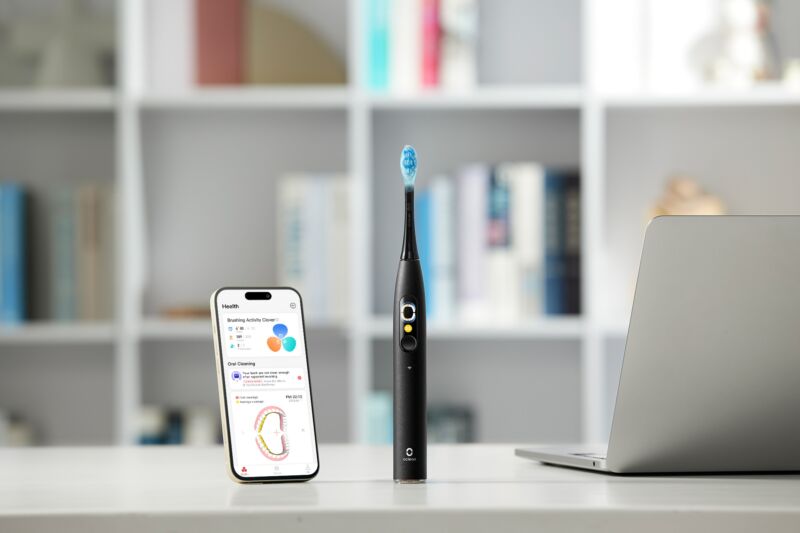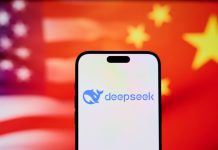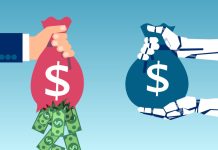App-connected toothbrushes bring new privacy concerns to the bathroom.

One of the most unlikely passengers on the AI gadgets hype train is the toothbrush. With claims of using advanced algorithms and companion apps to help you brush your teeth better, toothbrushes have become a tech product for some brands.
So-called “AI toothbrushes” have become more common since debuting in 2017. Numerous brands now market AI capabilities for toothbrushes with three-figure price tags. But there’s limited scientific evidence that AI algorithms help oral health, and companies are becoming more interested in using tech-laden toothbrushes to source user data.
AI toothbrushes
Kolibree was the first company to announce a “toothbrush with artificial intelligence.” The French company debuted its Ara brush at CES 2017, with founder and CEO Thomas Serval saying, “Patented deep learning algorithms are embedded directly inside the toothbrush on a low-power processor. Raw data from the sensors runs through the processor, enabling the system to learn your habits and refine accuracy the more it’s used.”
That’s pretty much how other AI toothbrush companies describe their products: There’s a vague algorithm working with an unnamed (likely cheap) processor and sensors to gather information, including how hard, fast, or frequently you brush your teeth. Typically, Bluetooth connectivity enables syncing this data with an app, purportedly letting users see interpretations of their brushing habits and how they could improve.
Kolibree now licenses its technology to Colgate-branded AI toothbrushes. The associated app, Colgate Connect, allows users to order Colgate products, sometimes at a discount. Other companies selling “AI toothbrushes” with connected e-commerce apps are Procter & Gamble’s (P&G’s) Oral-B, Philips, and Oclean, which announced a new tech-equipped toothbrush in July. Unlike many other toothbrushes, Oclean’s X Ultra can work with Wi-Fi.
ARS VIDEO
What Happens to the Developers When AI Can Code? | Ars Frontiers
An Oclean spokesperson told Ars Technica via email:
The toothbrush’s chip and accelerometer collect user behavior data. The embedded algorithm processes this data, and the brushing data is uploaded to the cloud in real time (no need to open the app once Wi-Fi is connected). Data processed on the toothbrush is displayed on the screen with limited dimensions, while cloud-processed results are shown on the mobile app with more dimensions and AI suggestions (based on recent or long-term brushing habits).
Assuming you could find an AI toothbrush that delivers on its claims by helpfully pointing out that you tend to miss your top-right molar, there’s reason to be skeptical about the necessity of such technology and the underlying motivations a brand may have in releasing an app-connected toothbrush.
AI toothbrushes help companies sell, develop products
Outside of toothbrushes, personal care brands have been seeking new ways to make money beyond selling units. As Stéphane Bérubé, CMO at beauty brand L’Oréal, put it, the industry can get value from selling services instead of just products. “I believe that the company that just sells products will not be successful,” she said at a 2018 marketing conference.
AI toothbrushes follow a similar approach. Toothbrushing tips act as a service, while the connected apps offer ways to potentially diversify a company’s business, make more revenue through product sales, and get an intimate understanding of how people use a product. The Oral-B toothbrush app, for example, can provide users information about their toothbrushing habits and recommend P&G products to buy while providing purchase links.
P&G has also discussed using AI in general as a way to get information that could help shape product development. As explained by P&G CIO Vittorio Cretella in a 2022 blog post, “algorithms can be defined to process consumer feedback on product changes and flag R&D engineers in real time, along with recommending adjustments accordingly.” As P&G’s R&D team has pointed out, traditional methods for collecting data on consumers, like surveys and focus groups, rely on self-reporting that can be inaccurate. Using tech to gather information about the way people use products is a way for corporations to address that flaw.
According to the R&D team:
This is where [AI]-activated insights reveal potentially hidden answers in product-usage patterns by letting the data speak for itself. For example, when people are asked how long they spend brushing their teeth, most say: “two minutes.” However, after analyzing in-use data from study participants, we know that the average person brushes for only 47 seconds. Knowing this helps us develop better products for dental health because we’re able to fine-tune formulations and products to provide maximum benefits based on the most common use.
Similarly, Colgate parent company Colgate-Palmolive has highlighted the benefits of using a toothbrush that can provide it with data. A 2022 blog post discussed Colgate-Palmolive using Apple ResearchKit with its 2018 AI toothbrush to “crowdsource toothbrushing data, which would accelerate innovation.” The post said that “there’s no sense in collecting data unless it’s used to learn, to spark new ideas and new solutions.” It also quoted Colgate-Palmolive’s director of digital design, Aviva Buivid, as saying that Colgate’s toothbrush app can “facilitate an ongoing relationship with people, something that’s impossible with our strictly physical products.”
Since launching AI toothbrushes, P&G has talked about using technology in its products to understand customers so it can better sell and develop products. In 2020, after P&G announced its first AI toothbrush, then-CEO David Taylor talked to Forbes about the company’s newfound interest in Internet and AI-equipped products bringing “a true understanding of the consumer as a human” and informing how P&G packages and communicates about products to shoppers.
P&G Chief Brand Officer Marc Pritchard also discussed how data derived from toothbrushes could help marketing efforts:
When you think about it, if you have [an] Oral-B iO [toothbrush] that has all of this AI in it—all this information and telling you exactly where you’re brushing every single day—why do you need an ad? When you have a smart store with an IoT cap in it or a retail execution that is so engaging, then you think, why do I need ads to broadcast? That’s where this is starting to take us: how technology embedded in everyday products can literally replace ads.
Privacy concerns
Tech-enabled toothbrushes bring privacy concerns to a product that has historically had zero privacy implications. But with AI toothbrushes, users are suddenly subject to a company’s privacy policy around data and are also potentially contributing to a corporation’s marketing, R&D, and/or sales tactics.
Privacy policies from toothbrush brands Colgate-Palmolive, Oral-B, Oclean, and Philips all say the companies’ apps may gather personal data, which may be used for advertising and could be shared with third parties, including ad tech companies and others that may also use the data for advertising. These companies’ policies say users can opt out of sharing data with third parties or targeted advertising, but it’s likely that many users overlook the importance of reading privacy policies for a toothbrush.
Some toothbrush brands also collect data from their products, not just their apps. For example, Oral-B’s policy says the company may collect data from its toothbrushes and the brushes’ sensors.
An Oral-B spokesperson declined to answer questions about how data gathered from toothbrushes is used to develop or promote P&G products or concerns about the necessity and privacy of its toothbrushes but shared a statement saying, in part:
Using the app is optional, and any information consumers choose to share is protected and in compliance with all applicable data privacy laws and regulations.
Philips’ Sonicare App privacy notice says the company collects “brushing details, including goals and other oral care habits/activities (such as flossing and rinsing), your answers to our Personalization page in the Onboarding Questionnaire and the Focus Area (such as your plaque build-up, bleeding areas, gum recession, and potential cavities); and your brushing start location (i.e., the location in your mouth where you want to start brushing),” as well as brushing data, “including your routine, session information, sensor data (such as brush mode, position, motion and pressure), battery level, and brush head type and lifespan.”
The policy says Philips collects this data to enable features like real-time brushing guidance, but also to recommend product purchases, like a replacement toothbrush head. Under the policy, Philips “associate[s] your oral care information with your account.”
And while most AI toothbrushes rely on Bluetooth to share data with its companion app, Oclean’s new X Ultra can connect to your Wi-Fi network. As highlighted by a viral news story earlier this year (which turned out to be hypothetical, not real), the Internet of Things (IoT) can open toothbrushes to newfound cybersecurity risks.
In an email, an Oclean spokesperson confirmed to Ars that the new brush’s Wi-Fi connectivity is optional; users can choose to connect the toothbrush to its app solely via Bluetooth.
Potential benefits
Plenty of people practice healthy, daily oral care without using AI, apps, Bluetooth, and Wi-Fi. But that doesn’t mean that these technologies can’t potentially offer real user benefits.
An April 2024 article published in the Journal of Clinical Periodontology explores the potential benefit of “artificial intelligence-enabled multimodal-sensing toothbrushes.” The researchers from Shanghai Jiao Tong University School of Medicine’s Department of Oral and Maxillofacial Implantology used P&G-provided Oral-B iO Series 9 brushes and the companion app for the study but said P&G “had no role in the study, including design, data analysis and interpretation, or writing of this manuscript.”
The paper notes that periodontitis is difficult to treat because of “patients’ poor performance and adherence to the necessary oral hygiene procedure.” The article suggested that the use of AI-enabled, multimodal-sensing toothbrushes could address this limitation and “transmit valuable data to clinicians, thus enabling effective remote monitoring and guidance.” The paper noted that the toothbrushes have the potential to drive “real-time coaching via an app, data transmission to the clinic team, and analysis to allow remote monitoring via targeted messaging” and drove “better levels and duration of oral hygiene.”
The article concluded:
The tested digital health intervention significantly improved the outcome of periodontal therapy by enhancing the adherence and performance of self-performed oral hygiene. The model breaks the traditional model of oral health care and has the potential to improve efficiency and reduce costs.
An American Academy of Periodontology spokesperson told me that the group “doesn’t have an official stance on AI toothbrushes.” When I followed up with the article from the Journal of Clinical Periodontology, president Dr. Stephen Meraw said:
There isn’t enough research to conclusively say that AI toothbrushes do a better job than non-AI toothbrushes, but maintaining a healthy at-home oral hygiene regimen is essential to periodontal health.
Dr. Ruchi Sahota, consumer advisor spokesperson for the American Dental Association (ADA), told me via email:
When it comes to manual versus powered brushes, some of which may include artificial intelligence features, what truly matters and will make a difference in your oral and overall health is that you’re effectively brushing twice a day with a fluoride toothpaste.
There’s currently one toothbrush claiming AI on the ADA’s list of dental products with its Seal of Acceptance.
There are at least some dentists who find the feedback that AI toothbrush apps can provide helpful. For example, Dr. Kim L. Capehart, an associate dean at the Dental College of Georgia at Augusta University, wrote in a 2021 article for the Decisions in Dentistry journal that “real-time feedback allows the individual to take corrective action immediately,” adding, “While the data in its purest form may not be something patients use on a daily basis, the instantaneous feedback these devices provide is invaluable. Not only to the patient, but also the provider if the user elects to share his or her brushing data.”
Noting that he has nothing against standard toothbrushes if a patient has good oral hygiene, Capehart said he would “absolutely recommend a smart toothbrush if the patient was open to app-enabled technology” (in this case, “smart” seems to refer to Bluetooth/app connectivity, not an Internet connection).
Toothbrushes as tech gadgets
As AI continues to be marketed as a toothbrush feature, consumers are left questioning if the technology really delivers on company promises and if any potential upsides are worth the tradeoffs.
Further, it’s uncertain how long companies will support these trendy tech features. Companies with limited backgrounds in tech, AI, apps, and/or hardware can disappoint when it comes to supporting app-connected hardware in the long term. Earlier this year, Oral-B bricked Amazon Alexa-enable toothbrushes that it released in 2020 for $230.
Oral-B’s representative declined to comment on concerns that its AI toothbrushes may not be supported in the long term. Oclean’s rep told me, “Oclean offers a 30-day money-back guarantee and a 2-year warranty, ensuring long-term support and customer satisfaction. Additionally, updates will be rolled out to the toothbrush and app periodically depending on product needs, with an approximate update cycle of once every six months.”
This article was updated with comment from the ADA.




